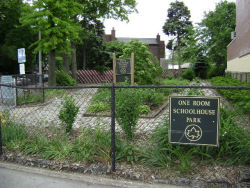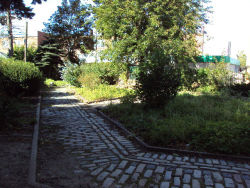One Room Schoolhouse Park
One Room Schoolhouse Park
Queens’ last one-room schoolhouse occupied this site from the time of its construction in 1879 until its demolition to make room for a public park in 1934. The park was named under a local law introduced by Council Members John D. Sabini and Helen M. Marshall, approved by the City Council, and signed into law by Mayor Rudolph W. Giuliani in 1996.
Compulsory school was first required by legislation in New York State in 1874, only five years before the one room schoolhouse opened. Last called P.S. 10, the school had also been known as the Bowery Bay School, for a school that was established in Steinway in 1734, and as the Frogtown School. The latter name was also applied to a poor community located in a swampy area to the north of Astoria Boulevard. The area was eventually filled in and redeveloped.
The surrounding neighborhoods were largely rural and sparsely settled during the school’s early existence. Many of the pupils were children of nearby farmers. The school was headed by Emma Fagan for thirty years. It had capacity for fifty-two students, divided into six classes, one for each year. The six rows of desks were arranged according to the age and ability of the students. The beginners were seated at the smaller desks in the front, while the more advanced students occupied the back rows.
By 1910, the one-room schoolhouse was considered antiquated in contrast to the public education system that was quickly expanding in more urban areas as a result of reform movements and to meet the needs of immigrants. Local concern was voiced that the school would be phased out in favor of a new institution in Corona. While the one-room schoolhouse was closed by 1925, a temporary school building was still in use at the time Parks acquired the property from the Board of Education in 1934.
New buildings and increased population in the neighborhood necessitated the construction of a new playground which opened to the public in December 1935. Subsequent decades saw the playground transformed into a sitting area that was popular with patrons of the public library once located across the street. When the library moved in the 1970s so did many of the park’s regular visitors. Rejuvenation of the park as a garden has been accomplished through a partnership between Parks and the Jackson Heights Neighborhood Association (formed in 1982).
Check out your park's Vital Signs
Clean & Safe
Green & Resilient
Empowered & Engaged Users
Share your feedback or learn more about how this park is part of a
Vital Park System


